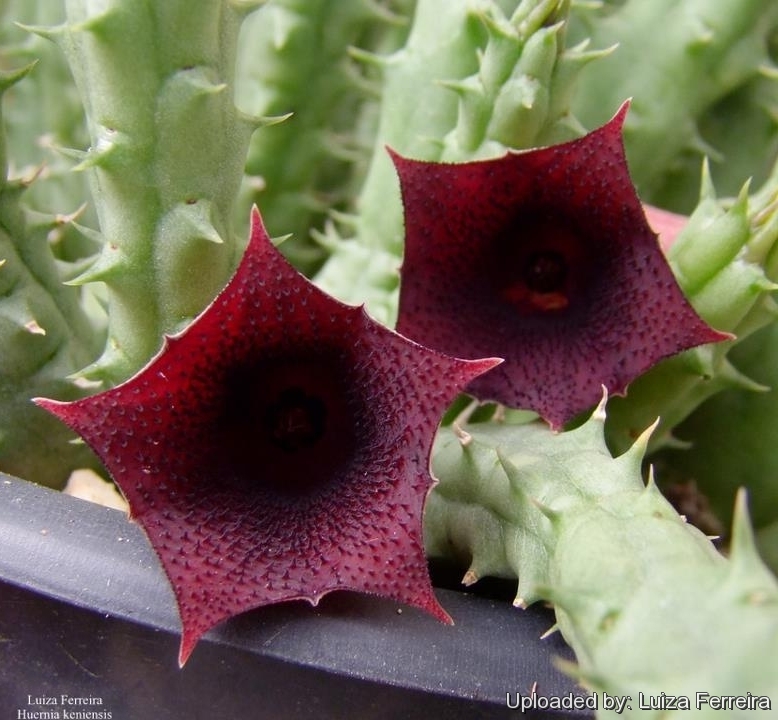
Huernia keniensis Photo by: Luiza Ferreira
Origin and Habitat: Huernia keniensisSN|25788]]SN|25788]] occurs in Kenya (counties Baringo, Kajiado, Laikipia, Makueni, Marsabit, Meru, Nairobi, Nakuru, Nandi, Narok, Nyeri, Samburu, Trans Nzoia) and Tanzania.
Altitude range: 1500-2000 metres above sea level.
Habitat and ecology: This species occurs in stony to rocky localities, usually in bright shade in the underbrush of the dry forests, where succulents abound, as usually seen with most members of the Stapelieae. It is not known whether H. Keniensis is common in its natural environment, but it is morphologically variable and quite commonly cultivated as an ornamental.
Synonyms:
See all synonyms of Huernia keniensis
Common Names include:
ENGLISH: Kenyan dragon flower
RUSSIAN (Русский): Гуэрния кенийская
Description: Huernia keniensisSN|26460]]SN|25788]] is a tropical, succulent species with 5-angled grey-green stems with some red mottling. The plant produces an abundance of star-like flowers with a distinctive ten-pointed corolla. Flowers are reddish to purplish covered with short warts and develops in succession. In H. keniensis 5 varieties have been recognized mainly based on differences in corolla size and shape.
Habit: It is a loose perennial plant readily offsetting to form low growing mounds up to 50 cm in diameter and 10 (or more) cm high.
Stems: Succulent, 5-angular, glabrous, without stipule, up to 12 cm long and c. 1 cm in diameter, prostrate-decumbent or erect, irregularly branching, grey-green with small brownish spots or reddish apex. Tubercles small to large and prominent, acute. Sap clear.
Leaves: Rudimentary or absent.
Flowers: 1-2 together. axillary, from the base or middle of the stems, bisexual, 5-merous. regular, drooping. Pedicel c. 5 mm long. Sepals triangular, c. 6 mm long. Corolla 2-2,5 cm in diameter in var. keniensis (larger in other varieties), deeply bell-shaped or cup-shaped to globose, outside red-dish to purplish, seldom cream-coloured, with pale venation, inside dark purple, densely papillose or sometimes glabrous. Corolla lobes broadly triangular, with revolute tips, 5-veined, sometimes with 5 smaller lobes in the angle between the main lobes, outside papillose-roughened. inside densely papillose. papillae conical or cylindrical, at the mouth of the tube and on the lobes obtuse, in the tube more delicate. Outer corona blackish purple. Inner corona lobes fused into a crenate disc. Outer corona-lobes apically slightly pointing upwards, narrow, with obtuse tips; Gynostegium tuberculate-papillose below the basal convexity.
Blooming season (in habitat): Flowers occur from June to October and do not have a carrion-like smell.
Fruit: A pair of follicles. When the follicles are fully-matured they burst open to release the seeds, each of which has a tuft of hair (or coma). It is self-sterile and flowers from different clones are needed to produce viable seeds.
Similar species: Huernia keniensisSN|25788]]SN|25788]] differs from Huernia asperaSN|25788]]SN|26460]] by the shorter, thicker, more erect and sharply toothed stems, by the larger and deeper corolla, whose tips are only slightly redurved and by the blackish-purple inner corona (yellow in H. aspera), which, is, however, very similar in structure to that of the latter.
Chromosome number: 2n = 22.
Subspecies, varieties, forms and cultivars of plants belonging to the Huernia keniensis group
 Huernia keniensis R.E.Fr.
Huernia keniensis R.E.Fr.- Huernia keniensis var. globosa L.E.Newton: has globose-urceolate corollas 20 x 25 mm, inside deep purple with minute papillae of uniform size. Distribution: Kenya. Rift Valley Prov.
- Huernia keniensis var. grandiflora P.R.O.Bally: corolla 5 cm Ø, outside parchment-white or dark with pale venation, lobes 3-veined with 2 additional veins, outside smooth, inside densely papillose. Distribution: Kenya, Samburu Distr.
- Huernia keniensis var. molonyae A.C.White & B.Sloane: corolla glabrous inside and outside, inside with few scattered hairs. Possibly an abnormal form of H. keniensis var. nairobiensis. Distribution: Kenya (Molony).
- Huernia keniensis var. nairobiensis A.C.White & B.Sloane: has stems to 18 cm long, tubercles more distinct; corolla larger, broadly funnel-shaped, lobes 3 veined, outside roughened, inside densely-papillose. Distribution: Kenya, Tanzania
Bibliography: Major references and further lectures
1) chmelzer, G.H. & Gurib-Fakim, A. “Medicinal plants 2” PROTA, 2013
2) Focke Albers, Ulrich Meve “Illustrated Handbook of Succulent Plants: Asclepiadaceae: Asclepiadaceae” Volume 4 Springer Science & Business Media, 2002
3) Vera Higgins “Succulent Plants Illustrated” Blandford Press, 1949
4) East Africa and Uganda Natural History Society “Journal of the East Africa and Uganda Natural History Society” Volumi 15-16 The Society., 1940
5) Werner Rauh “The Wonderful World of Succulents: Cultivation and Description of Selected Succulent Plants Other Than Cacti” Smithsonian Institution Press, 1984
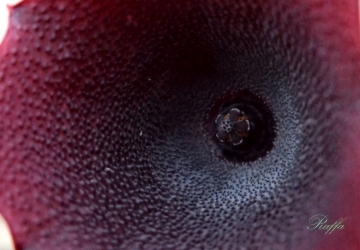 Huernia keniensis Photo by: Raffa C. Garcia
Huernia keniensis Photo by: Raffa C. Garcia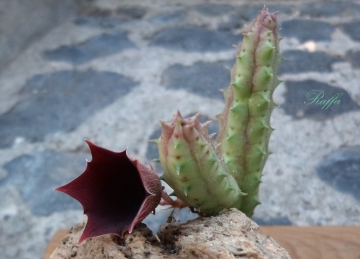 Huernia keniensis Photo by: Raffa C. Garcia
Huernia keniensis Photo by: Raffa C. Garcia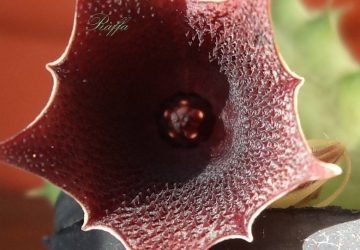 Huernia keniensis Photo by: Raffa C. Garcia
Huernia keniensis Photo by: Raffa C. Garcia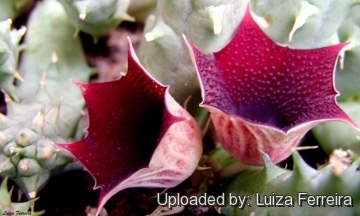 Huernia keniensis Photo by: Luiza Ferreira
Huernia keniensis Photo by: Luiza Ferreira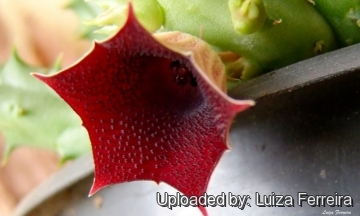 Huernia keniensis Photo by: Luiza Ferreira
Huernia keniensis Photo by: Luiza Ferreira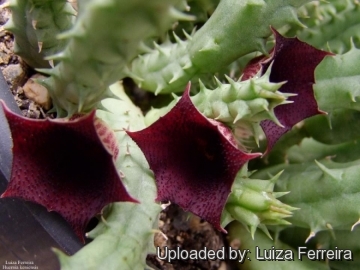 Huernia keniensis Photo by: Luiza Ferreira
Huernia keniensis Photo by: Luiza Ferreira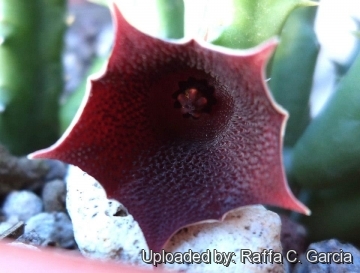 Huernia keniensis Photo by: Raffa C. Garcia
Huernia keniensis Photo by: Raffa C. Garcia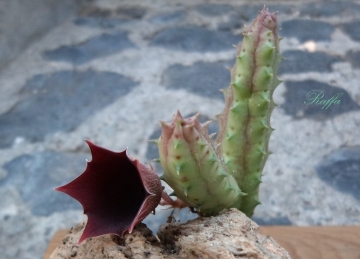 Huernia keniensis Photo by: Raffa C. Garcia
Huernia keniensis Photo by: Raffa C. GarciaCultivation and Propagation: Huernia keniensis isn't difficult to grow and flower.
Spring: When winter ends and they begin to grow again, they will require much water and soaking the pots will no longer put the plants at risk for rot. In the spring they will grow well in partial shade and leaving them out in the rain may provide them with the water they need.
Summer: In the summer months they will tolerate heavy rain, but will be just as happy if the season is dry. It's best to sort out the stems while the plants are resting in the summer before they begin their autumnal growth cycle. They will tolerate very hot weather outdoors as long as they are kept in filtered light and this will encourage them to flower in the Autumn. They also enjoy some fertiliser. Moving the plants as they are developing buds may cause them to spontaneously abort the flowers all together.
Autumn: In the fall keep them outdoors until the night time temperatures drop below the 10°C.
Winter: Winter care presents no problems at 10° C with plenty of light. As soon as they are flowered be sure to take extra precautions to keep them dry, because damp cool conditions when the plants are resting is an invitation to fungal infections, but - according to temperatures –some occasional lit watering may be useful.
Potting medium: Since roots are quite shallow, use a cactus mix or add extra perlite or pumice to regular soil potting soil. A gritty, very free-draining compost is suitable, and clay pots help the plants to dry out between watering. Re-pot every 2 years.
Pest and diseases: Huernia are generally fairly easy to grow, especially if kept pest-free. They are very susceptible to stem and root mealy bugs, and damage from these may well initiate fungal attack. Any time when there is a dead or dying stem in the pot it is important to remove it immediately and completely before other healthy stems can become ill too, isolate the healthy parts, dry them off, and re-root them in new compost. It should not be exposed to direct sun that make stem turn brown, and stops growth.
Uses: Huernia henienais is grown as an ornamental in rock gardens and containers.
Medicinal uses: In Kenya the sap from the stem is applied to wounds to dry them.
Propagation: Easiest with stem cuttings. Allow cuttings to dry a day before planting. Stems must be laid (Not buried) on gritty compost and will then root from the underside of the stems. It can also be increased from seeds sowing in spring in moist, sandy peat moss. Barely cover seeds. Seeds germinate quickly.
In any season it's best to lay the stems out for several days before replanting them and then pot them only in dry soil and withhold any water until they begin to shrivel or start growing again.
Your Photos

by Raffa C. Garcia




















